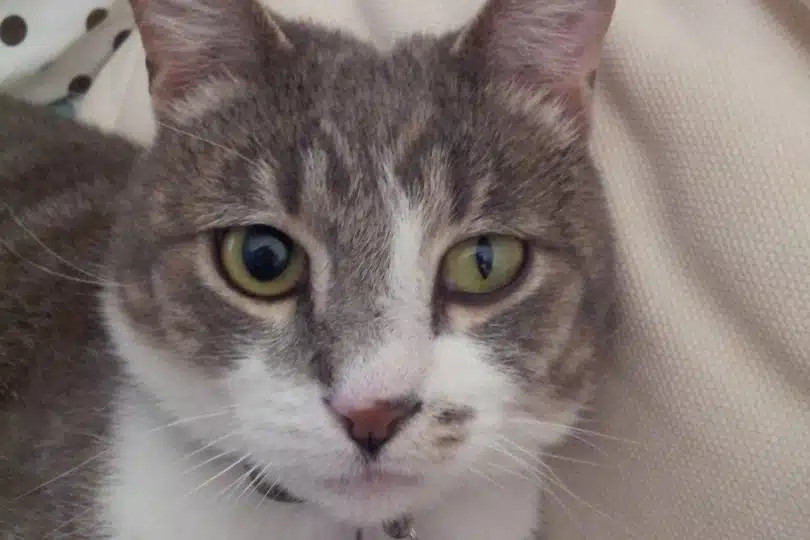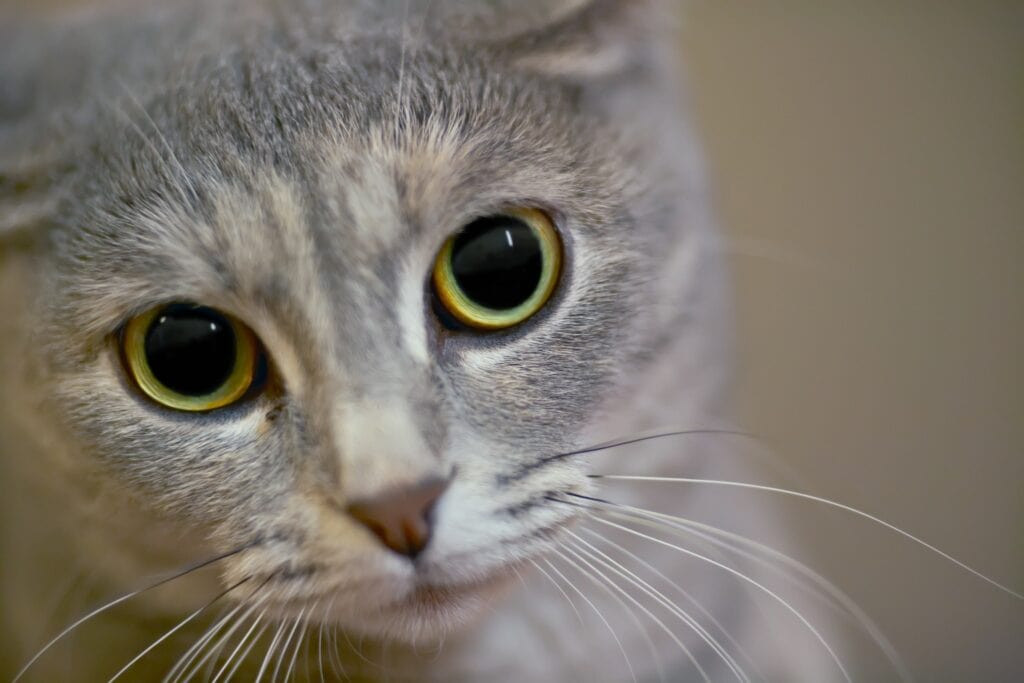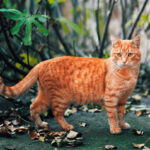Dilated cat eyes, also known as mydriasis, can be a common yet sometimes concerning sight for cat owners. Observing your feline friend’s pupils widen can be intriguing, and while it’s often a normal physiological response, it’s important to understand when dilated pupils in cats might signal a potential health issue.
A cat’s pupils are dynamic, naturally expanding and contracting to regulate the amount of light entering their eyes and reflecting their emotional state. While these changes are usually benign, persistent or unusually dilated pupils can sometimes indicate underlying problems that require veterinary attention.
This article will delve into the various reasons behind dilated cat eyes. We’ll explore the normal fluctuations in pupil size, the common causes of mydriasis, and, crucially, when you should seek professional veterinary advice to ensure your cat’s well-being.
Normal Cat Pupil Function
In healthy cats, pupils are incredibly responsive, changing size and shape based on both light levels and emotional cues. Typically, in moderate light, a cat’s pupils appear as vertical slits. This is often seen when they are relaxed and content. However, when a cat becomes excited, playful, or enters a low-light environment, their pupils will naturally dilate, becoming round and larger to maximize light intake and enhance vision.
 dilated cat eyes
dilated cat eyes
Common Causes of Dilated Pupils in Cats
Dilated pupils in cats, or mydriasis, can stem from a range of factors, from normal physiological responses to potential health concerns. Understanding these causes is key to discerning when your cat’s dilated eyes are normal and when they might warrant a vet visit.
Low Light Conditions: The most frequent and benign reason for dilated pupils is simply low light. Just like human eyes, a cat’s eyes are designed to adapt to varying light levels. In dim environments, the pupils dilate to allow more light to reach the retina, improving their night vision and ability to see clearly. This is a perfectly normal and healthy response.
Excitement and Play: Observe your cat during playtime, and you’ll likely notice their pupils dilate. This is a natural physiological response to excitement, arousal, and heightened sensory input. The ‘fight or flight’ response, even in play, can trigger pupil dilation as the body prepares for action.
Fear and Anxiety: Similar to excitement, fear or anxiety can also cause a cat’s pupils to dilate. This is again related to the ‘fight or flight’ response. Dilated pupils in a fearful cat help them take in as much visual information as possible from their surroundings, enhancing their awareness of potential threats.
Pain or Discomfort: Dilated pupils can be a significant indicator of pain or discomfort in cats. If you notice your cat’s pupils are dilated in conjunction with other signs of distress such as hiding, decreased appetite, changes in vocalization (excessive meowing or hissing), or reluctance to be touched, it’s crucial to consider pain as a potential cause and consult with a veterinarian.
TikTok user @echothebengal demonstrates how his pupils dilate before attacking a family member.Medical Conditions Associated with Mydriasis
While many instances of dilated pupils are harmless, several underlying medical conditions can manifest as persistent or unusual pupil dilation in cats. Recognizing these potential health issues is vital for early diagnosis and treatment.
Hypertension (High Blood Pressure): High blood pressure in cats, often secondary to conditions like chronic kidney disease or hyperthyroidism, can lead to dilated pupils. Other signs of hypertension in cats can include weight loss, changes in appetite, lethargy, and poor coat quality. Hypertension can have serious consequences if left untreated, making regular veterinary check-ups important, especially for older cats.
Eye Disorders: Various eye conditions can directly cause dilated pupils. Glaucoma, characterized by increased pressure within the eye, and uveitis, inflammation of the middle layer of the eye, are both known to result in mydriasis. These conditions can be painful and sight-threatening, necessitating prompt veterinary intervention.
Progressive Retinal Atrophy (PRA): PRA is a degenerative disease affecting the retina, the light-sensitive tissue at the back of the eye. As the cells in the retina deteriorate, it can lead to vision loss and dilated pupils as the eye attempts to compensate for reduced light sensitivity.
Glaucoma: As mentioned, glaucoma involves increased intraocular pressure and is a serious condition that can cause dilated pupils, often in one or both eyes. It’s crucial to seek immediate veterinary attention if you suspect glaucoma in your cat, as it can lead to blindness if not managed.
Iris Atrophy: Iris atrophy is a degenerative condition causing thinning of the iris, the colored part of the eye. This thinning can sometimes appear as “holes” in the iris structure and can result in dilated pupils, often unilaterally (affecting only one eye).
Ocular and Brain Tumors: Tumors affecting the eye structures or the brain can also trigger persistent dilated pupils. Depending on the tumor’s location and type, other accompanying signs might include chronic pain, changes in the third eyelid, unusual eye discharge, and cloudiness of the eyes. Neurological signs may also be present with brain tumors.
Anisocoria (Unequal Pupil Size): Anisocoria refers to a condition where a cat’s pupils are of unequal sizes, with one pupil being more dilated than the other. This can be a subtle but significant sign. Anisocoria can be caused by various issues, including corneal ulcers, Horner’s syndrome, and head trauma. It always warrants veterinary investigation.
Poor Vision: As a cat’s vision deteriorates due to age or underlying conditions, their pupils may dilate in an attempt to gather more light and improve visual acuity. Cats with poor vision may also squint frequently, bump into objects, or exhibit other signs of visual impairment.
Feline Dysautonomia (Key-Gaskell Syndrome): Feline dysautonomia is a rare neurological condition affecting the autonomic nervous system. Dilated pupils are a classic symptom, along with other signs such as respiratory difficulties, gastrointestinal upset, and changes in heart rate.
 anisocoria
anisocoria
Image Credit: Example of anisocoria in a cat (Blumoon531, via Wikimedia Commons, CC BY-SA 4.0)
When is it Necessary to Seek Veterinary Care for Dilated Cat Eyes?
While occasional pupil dilation is often a normal occurrence, it’s essential to know when dilated cat eyes become a cause for concern and necessitate a veterinary visit. Prompt veterinary care can be crucial in addressing underlying health issues and preventing potential complications.
-
Persistent Dilation: If you observe that your cat’s pupils remain dilated for an extended period, particularly in bright light conditions where they should normally constrict, this is a strong indicator of a potential problem. Persistent mydriasis warrants veterinary evaluation.
-
Accompanying Symptoms: Pay close attention to whether dilated pupils are accompanied by other symptoms. Lethargy, vomiting, loss of appetite, changes in behavior such as increased hiding, vocalization, or any signs of pain or distress are all red flags. The presence of these symptoms alongside dilated pupils significantly increases the likelihood of an underlying medical issue.
-
Ocular Abnormalities: Carefully examine your cat’s eyes for any other abnormalities. Cloudiness, discharge (especially if it’s not clear), redness, swelling around the eyes, or any visible trauma to the eye are all reasons to seek immediate veterinary care.
-
Age-Related Considerations: Senior cats are more susceptible to developing health conditions that can cause dilated pupils. Regular veterinary check-ups are particularly important for older cats to monitor for age-related health issues and address any concerns proactively. Any new onset of persistent dilated pupils in a senior cat should be promptly evaluated.
What to Expect During a Veterinary Examination
If you take your cat to the veterinarian due to concerns about dilated pupils, the vet will conduct a thorough examination to determine the underlying cause. This typically involves:
- Comprehensive Physical Examination: A general health check, including listening to the heart and lungs, palpating the abdomen, and checking vital signs.
- Baseline Diagnostic Tests: These may include bloodwork (complete blood count and biochemistry profile), urinalysis, and blood pressure measurement to assess overall health and screen for systemic diseases like kidney disease or hypertension.
- Ophthalmic Examination (Ophthalmoscopy): A detailed examination of the eye using an ophthalmoscope to visualize the retina, optic nerve, and blood vessels within the eye. This helps assess for retinal diseases, optic nerve abnormalities, and other internal eye problems.
- Tonometry: Measurement of the intraocular pressure (pressure inside the eye) using a tonometer. This is crucial for diagnosing glaucoma.
- Ocular Ultrasound: In some cases, an ultrasound of the eye may be performed to evaluate the internal structures of the eye in more detail, particularly if there is cloudiness or opacity preventing a clear view with ophthalmoscopy.
- Advanced Imaging (CT Scan or MRI): If a brain tumor or neurological condition is suspected, advanced imaging such as a CT scan or MRI of the head may be recommended to visualize the brain and surrounding structures.
Vision Loss and Dilated Pupils
When a cat experiences vision loss, regardless of the cause, their pupils often dilate as a natural compensatory mechanism. By dilating, the eyes attempt to maximize light entry to improve visual input, even if vision is impaired. If you observe dilated pupils along with behavioral changes suggestive of vision loss, it’s essential to consider vision impairment as a possible factor.
Recognizing Signs of Vision Loss in Cats:
- Hesitation with Jumping or Climbing: Cats with vision loss may become hesitant to jump onto or down from elevated surfaces they previously navigated easily.
- Squinting: While squinting can indicate pain, it can also be a sign of trying to improve blurry vision.
- Redness Around the Eyes: Inflammation or underlying eye conditions causing vision loss may sometimes present with redness around the eyes.
- Cloudy or Milky Appearance of Eyes: Cataracts or corneal opacities can cause the eyes to appear cloudy or milky.
- Unsteadiness While Walking: Vision-impaired cats may exhibit unsteadiness, bumping into objects or appearing disoriented.
- Difficulty Locating Food or Water: They may struggle to find their food or water bowls, especially if they are moved from their usual locations.
- Walking with Whiskers Down: Holding whiskers closer to the ground can be a tactile strategy to navigate their surroundings when vision is compromised.
- Startling Easily at Sudden Noises: Relying more on hearing, they may be more easily startled by sudden sounds as they are less able to anticipate movement visually.
- Increased Vocalization: Disorientation and anxiety associated with vision loss can sometimes lead to increased meowing or other vocalizations.
Simple Vision Tests You Can Do at Home
You can perform some basic, non-invasive tests at home to get a preliminary sense of your cat’s vision. These are not substitutes for a veterinary eye exam, but can provide helpful clues:
- Laser Pointer Test: Swiftly move a laser pointer dot across the floor in front of your cat. A sighted cat should visually track and often attempt to chase the light.
- Cotton Ball Test: Toss cotton balls gently in your cat’s path. Most cats will visually track and often interact with cotton balls.
- Hand Waving Test: Gently wave your hand towards your cat’s eyes (without creating a breeze). A cat with normal vision should blink in response to the approaching movement.
- Bright Light Reflex Test: Briefly shine a bright light (like a penlight) into your cat’s eyes. The pupils of a sighted cat should constrict in response to the light.
Adapting Your Home for a Blind Cat
If your cat is diagnosed with permanent blindness, there are many ways to adapt your home and routine to ensure their safety and well-being:
- Maintain Familiar Environment: Keep furniture arrangements consistent. Avoid rearranging furniture or adding new obstacles, as this can disorient a blind cat.
- Verbal Communication: Talk to your cat frequently in a calming and reassuring voice. Verbal cues become more important for navigation and reassurance.
- Announce Your Presence: Avoid startling your cat by announcing your presence before approaching or touching them.
- Clear Pathways: Ensure clear, unobstructed pathways throughout your home to prevent tripping hazards.
- Minimize Loud Noises: Reduce exposure to loud or sudden noises that could startle or distress a blind cat, as they rely more heavily on their hearing.
 grey cat with dilated cat eyes
grey cat with dilated cat eyes
In Conclusion: Understanding Dilated Cat Eyes
Dilated cat eyes are a multifaceted sign in felines. While often a normal response to environmental or emotional factors, persistent or unusual dilation can be an important indicator of underlying health problems.
Being observant of your cat’s pupils and understanding the context in which dilation occurs is crucial for responsible pet ownership. Recognizing the common causes and knowing when dilated pupils warrant veterinary attention empowers you to proactively safeguard your feline companion’s health and well-being. If you ever have concerns about your cat’s eye health or notice persistent dilated pupils, always err on the side of caution and consult with your veterinarian for professional guidance and peace of mind.

